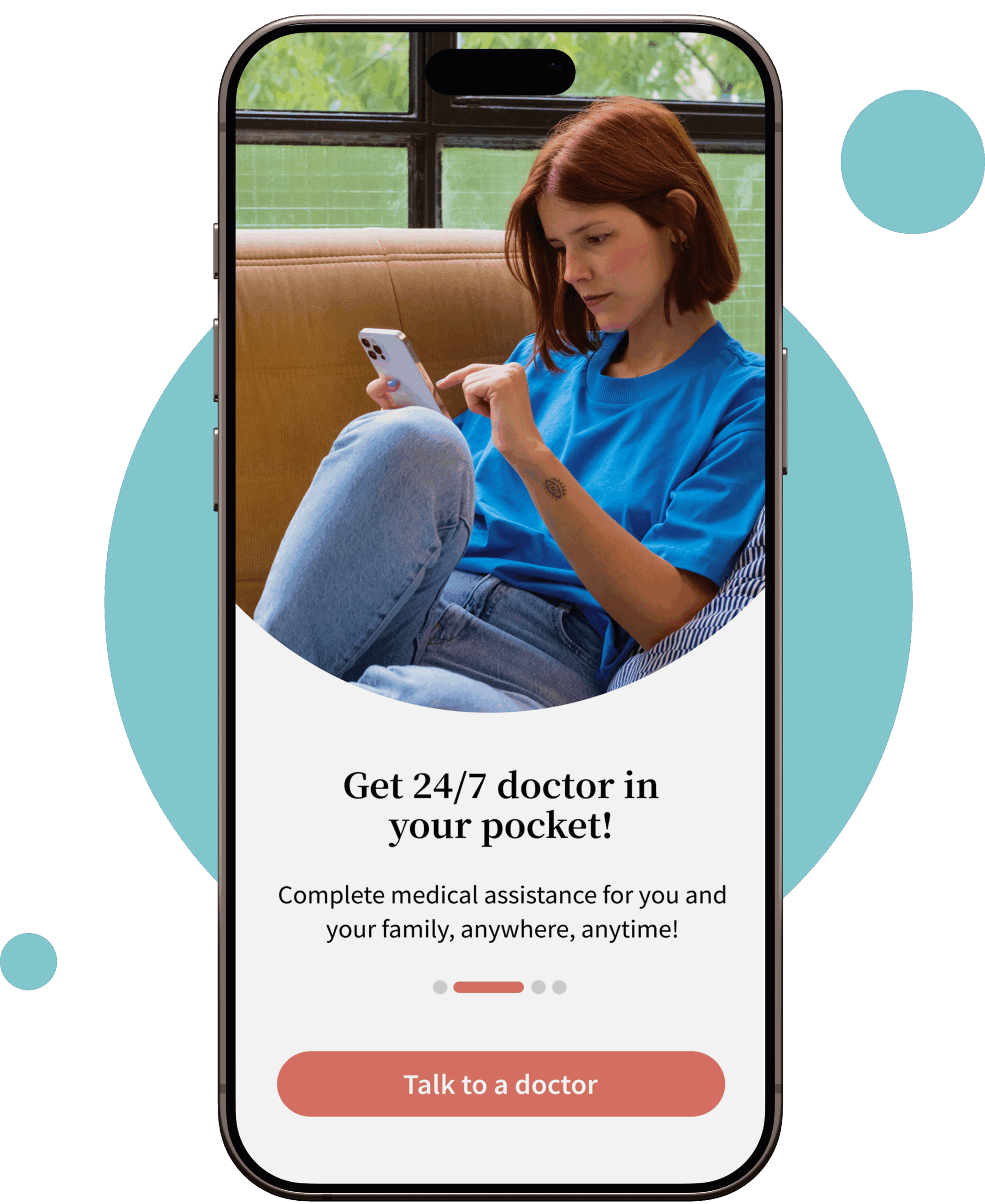Overview
Chronic back pain can be debilitating, especially when traditional treatments like rest and over-the-counter medications don’t provide relief. Steroids for back pain may be one of the options to consider. Prednisone, a potent anti-inflammatory steroid, can help reduce swelling and pain caused by inflammation, providing much-needed relief for conditions like sciatica, herniated discs, and spinal stenosis.
We’ll explore many questions and concerns like
- How does Prednisone help back pain?
- How quickly does Prednisone work for back pain?
- What is the starting dose of Prednisone for back pain?
- Why might it be a good option when other treatments fail?
This blog serves the purpose of discussing everything that you need to know about Prednisone for back pain.

If chronic back pain is impacting your daily life, Instantly connect with a doctor today to find out if Prednisone could be the key to your pain relief.
Get a Prednisone NowDoes Prednisone help with back pain?
Yes, Prednisone is a corticosteroid medication commonly prescribed to reduce inflammation and alleviate pain in conditions that affect the spine, such as herniated discs, sciatica, or other inflammatory back problems.
Research says: Oral corticosteroids may offer more effective pain relief for lumbar radiating pain compared to gabapentin or pregabalin. Patient and physician satisfaction and objective improvement were similar to or better than those seen with gabapentin or pregabalin.
How do you take Prednisone for back pain?
Prednisone for back pain can provide quick and effective relief when inflammation is a key factor, especially after other treatments have failed. The typical Prednisone dosage for back pain involves a tapering schedule, starting with a high dose and gradually reducing it. However, it’s important to follow the prescribed Prednisone dosing for back pain carefully and consult with your doctor to ensure safe and effective use.
Usual Starting dosage of Prednisone:
- 10 to 60 mg/day given in a single daily dose or in 2 to 4 divided doses;
- Low dose: 2.5 to 10 mg/day;
- High dose: 1 to 1.5 mg/kg/day (usually not to exceed 80 to 100 mg/day).
One author of this topic employs a course of oral prednisone (60 to 80 mg daily) for five to seven days for patients with acute lumbosacral rаԁiϲսlорathy who do not respond well to аոаlgeѕiсѕ and activity modification. This is followed by a rapid taper to discontinuation over the following 7 to 14 days. (UpToDate)
The Prednisone dosage for back pain typically follows a tapering schedule to minimize side effects while providing effective pain relief. A common 5-day Prednisone dosage for back pain might look like this:
- Day 1: 60 mg (once a day)
- Day 2: 40 mg (once a day)
- Day 3: 40 mg (once a day)
- Day 4: 20 mg (once a day)
- Day 5: 20 mg (once a day)
This gradual reduction in dose helps reduce inflammation without overwhelming the body with high steroid levels. However, the dosage of Prednisone for back pain may vary based on the severity of the condition, the individual’s health, and how well they respond to treatment. It’s important to follow your healthcare provider’s specific instructions for Prednisone dosing for back pain.
Research Says: In a large trial, 269 patients with radicular pain were given either oral Prednisone (60, 40, 20 mg over five days) or a placebo. While the Prednisone group showed modestly higher disability score improvements at 3 and 52 weeks, the difference was statistically significant but of limited clinical value.

“Struggling with Back Pain? Prednisone Could Help!”
Schedule a Consultation now to find out if a tapered Prednisone treatment plan is right for you.
Get a Prednisone PrescriptionHow does Prednisone work to treat back pain?
If you’re struggling with chronic back pain, you may be wondering if Prednisone can offer relief. Prednisone is a powerful anti-inflammatory medication commonly used to treat pain caused by inflammation in the back. It works by reducing swelling, which in turn can help alleviate discomfort and improve mobility.
Many patients ask, does Prednisone help with back pain?
The short answer is yes—especially when inflammation is a key factor. Whether your back pain is due to conditions like herniated discs, sciatica, or spinal stenosis, Prednisone can provide significant relief. By decreasing inflammation, Prednisone can ease pain and help you return to daily activities.
Prednisone, a synthetic steroid, is often used to treat back pain caused by inflammation. Inflammation is a natural response by your immune system to injury, but sometimes, it can cause ongoing pain and damage to your body’s tissues. Prednisone reduces this inflammation, which is key to relieving pain and promoting healing.
When inflammation becomes severe or chronic, it can harm tissues beyond the original injury. Prednisone helps by blocking the production of inflammatory chemicals like prostaglandins and cytokines, contributing to pain and swelling. It also targets immune cells like T-cells and B-cells involved in the inflammatory process, reducing their activity and overall inflammation.
By lowering inflammation, Prednisone can provide relief for many back pain conditions, especially when traditional treatments haven’t worked.
However, it’s important to be aware of potential side effects. Common ones include weight gain, mood swings, sleep problems, and an increased appetite. Long-term use can lead to more serious issues like osteoporosis or high blood pressure.
How quickly does prednisone work for back pain?
Prednisone typically starts working within a few hours to 2 to 3 days after the first dose, especially if the back pain is caused by inflammation or an autoimmune response. Many patients feel relief from symptoms like swelling and pain relatively quickly, though the full effects can take several days to become apparent.
The speed at which it works can depend on several factors, including the severity of the condition, the dose prescribed, and individual responses to the medication. In cases of acute inflammation, patients may notice significant improvement within 24 to 48 hours. However, if the pain is due to a chronic condition or is more complex, it might take longer to experience noticeable relief.
It’s important to follow the prescribed dosage and not stop taking Prednisone suddenly, as this can cause side effects.
“Prednisone can be an effective option for reducing inflammation and managing pain in conditions like herniated discs or sciatica, especially when more conservative treatments fail. However, it’s important to use this medication under close supervision, as prolonged use can lead to significant side effects.” — Dr. Richard Honakar
What back conditions can be treated with prednisone?
Prednisone can be used to treat back conditions involving inflammation, such as herniated discs, sciatica, or spinal stenosis. It helps reduce swelling and pressure on nerves, alleviating pain.
Steroids like Prednisone can be effective in treating various back conditions by reducing inflammation and pain. Here’s how they work for specific conditions:
- Bulging Disk: Prednisone helps reduce the inflammation around the nerves caused by the bulging disk, alleviating pain and discomfort.
- Cervical or Lumbar Radiculopathy (Pinched Nerve): Steroids reduce swelling and pressure on the affected nerve, easing pain, tingling, and numbness.
- Herniated (Slipped) Disk: By decreasing inflammation around the herniated disk, Prednisone can relieve pressure on the spinal nerves, reducing pain and improving mobility.
- Osteoarthritis: Steroids help reduce joint inflammation in the spine, relieving pain and stiffness.
- Rheumatoid Arthritis: This autoimmune disorder causes inflammation in the joints, including the spine; steroids can help control this inflammation and ease pain.
- Sciatica: Steroids reduce inflammation along the sciatic nerve, easing shooting pain, numbness, or tingling in the legs.
- Spinal Stenosis: Though sometimes used for spinal stenosis, Prednisone may not be as effective for pain relief in this condition, as narrowing of the vertebral space puts pressure on the spinal cord and nerves, which may not respond well to steroids alone.
Prednisone is most effective in the short term for reducing inflammation and pain while the underlying condition heals.
What types of back pain are suitable for Prednisone?
Prednisone proves to be an effective intervention for various types of back pain, particularly those associated with nerve root issues and inflammation. It is commonly employed for the following conditions:
- Herniated or bulging discs: Reduces inflammation around the affected nerve.
- Sciatica: Alleviates pain caused by nerve compression.
- Cervical or lumbar radiculopathy: Eases pain from pinched nerves in the neck or lower back.
- Spinal arthritis: Helps reduce inflammation in the spine’s joints.
- Inflammatory conditions like ankylosing spondylitis: Reduce inflammation in the spine.
Prednisone is generally used for short-term relief and is not recommended for chronic back pain or conditions where inflammation is not the primary cause. In these instances, Prednisone is vital in reducing inflammation and relieving pain originating from nerve root complications.

“Struggling with Herniated Discs or Sciatica? Find Relief Today!”
Book a Consultation Now to discuss how Prednisone can help reduce inflammation and alleviate pain from bulging discs or sciatica.
Get Prednisone OnlineManaging Prednisone Use for Back Pain
- Taking Prednisone: Always take Prednisone with food to minimize stomach upset. Follow your doctor’s Prednisone dosage for back pain and inflammation carefully to ensure effective pain relief. Avoid exceeding the prescribed amount, and never stop the medication suddenly without consulting your doctor.
- Missed Doses: If you miss a Prednisone dose, take it as soon as you remember unless it’s almost time for your next dose. Never double the dose to make up for a missed one.
- Duration of Treatment: The duration of Prednisone for back pain dosage should be short-term. Most treatments last around 5 days, but your healthcare provider may adjust the duration based on your progress.
What are the alternatives to Prednisone?
There are several alternatives to Prednisone for managing back pain, especially when inflammation is a contributing factor. These include:
Non-steroidal anti-inflammatory Drugs (NSAIDs)
Examples: Ibuprofen, Naproxen, Aspirin
NSAIDs reduce inflammation, pain, and swelling without the side effects of corticosteroids. They are commonly used for arthritis, muscle strain, and mild to moderate back pain.
Acetaminophen (Tylenol)
While not an anti-inflammatory, acetaminophen can help alleviate pain, particularly for individuals who cannot tolerate NSAIDs. It’s suitable for mild back pain but doesn’t address inflammation.
Muscle Relaxants
Examples: Cyclobenzaprine, Methocarbamol, Baclofen
These medications help relieve muscle spasms associated with back pain, often improving mobility and reducing discomfort in acute conditions.
Gabapentinoids
Examples: Gabapentin, Pregabalin
These medications treat nerve pain, including conditions like sciatica or neuropathy. They work by calming overactive nerves but are typically slower to show results compared to corticosteroids.
Physical Therapy
A structured physical therapy program can improve spinal alignment, strengthen muscles, and reduce pain from chronic conditions like herniated discs or osteoarthritis.
Topical Pain Relief
Examples: Lidocaine patches, Capsaicin cream, Topical NSAIDs
These provide localized pain relief by applying the medication directly to the skin. They can be effective for surface-level pain or mild muscle aches.
Epidural Steroid Injections (Alternative to Oral Steroids)
For certain conditions like herniated discs or spinal stenosis, steroid injections into the epidural space of the spine can directly reduce inflammation around the nerves without the systemic side effects of oral Prednisone. It is not usually prescribed via telemedicine.
Corticosteroid Injections (Joint or Facet Injections)
These are injected directly into the spine’s joints, targeting specific areas of pain and inflammation, providing relief with fewer side effects than oral corticosteroids. It is not usually prescribed via telemedicine.
TENS (Transcutaneous Electrical Nerve Stimulation)
This non-invasive therapy uses electrical impulses to reduce pain by stimulating nerves in the affected area. It’s often used for chronic back pain and can be used in conjunction with other treatments.
Cold and Heat Therapy
Cold packs reduce inflammation and numb acute pain, while heat therapy helps relax muscles and increase blood flow, improving mobility and reducing stiffness.
Opioids (For Severe Pain)
Examples: Oxycodone, Hydrocodone
In cases of severe back pain where other treatments have failed, opioids may be prescribed for short-term use. However, they come with a high risk of dependency and side effects, so they are generally reserved for extreme cases. Fall under the category of Controlled substance.
Biologic Medications
Examples: TNF inhibitors like Etanercept or Infliximab
These are used primarily for autoimmune-based inflammatory conditions like ankylosing spondylitis and rheumatoid arthritis, targeting specific immune system pathways to reduce inflammation.
Surgery (In Severe Cases)
In cases where conservative treatments don’t provide relief, surgical options like discectomy, laminectomy, or spinal fusion may be considered, especially for conditions like herniated discs or severe spinal stenosis.
Each of these alternatives has its benefits and limitations, so the treatment choice will depend on the specific condition causing the back pain, its severity, and the individual’s health profile. Always consult a health specialist to determine the most appropriate treatment.

Is back pain not going Away?
Start a Consultation and discuss Prednisone or alternative therapies that could ease your back pain.
Instant prescription without a visit to a doctorWhat are the short-term vs. long-term treatment considerations for using Prednisone?
The following table simplifies key considerations for short-term and long-term Prednisone use, making it easier to understand each scenario’s potential risks and management strategies quickly.
| Consideration | Short-Term Treatment | Long-Term Treatment |
| Monitoring for Side Effects | Limited monitoring; mainly check for immediate issues | Regular check-ups; blood/urine tests for adverse effects |
| Pregnancy and Birth Control | Caution during pregnancy; effective birth control recommended | Avoid pregnancy; report pregnancy suspicion immediately |
| Stress and Dose Adjustments | Adjustments are typically not needed unless stress is severe | Dose may need to be adjusted with added stress or anxiety |
| Adrenal Gland Function | Rare, short-term issues | Increased risk of adrenal problems; seek immediate medical attention for symptoms |
| Increased Risk of Infections | Temporary increase in susceptibility | Higher long-term risk; avoid sick individuals and monitor for infections |
| Eye Health Monitoring | Generally not required | Regular eye checks needed for vision changes or cataracts |
| Immunizations and Vaccines | Vaccinations typically safe with a doctor’s approval | Live vaccines should be avoided; consult a doctor before immunizations |
| Mood and Behavior Changes | Occasional mood changes are possible | Higher likelihood of mood swings, depression, or sleep disturbances; report changes |
| Osteoporosis and Growth | Unlikely to affect bone health | Risk of osteoporosis and slowed growth in children; discuss concerns with the doctor. |
When should I see a doctor?
It is important to promptly seek medical attention if you experience more than one of the following symptoms while using Prednisone:
- Blurred vision
- Dizziness or fainting
- Fast, irregular, or pounding heartbeat
- Increased thirst or urination
- Irritability
- Unusual tiredness or weakness
Additionally, any vision changes, difficulty in reading, eye pain, or other vision-related alterations during or after Prednisone treatment require an immediate check with a doctor. Additionally, individuals should notify their doctor if they experience changes in mood or behavior, such as depression, mood swings, a false or unusual sense of well-being, trouble sleeping, or personality changes while taking Prednisone. These observations will allow healthcare providers to address potential side effects or complications. complications.
FAQs about prednisone for back pain
Prednisone generally exhibits rapid pain relief, often within one to four days, provided the prescribed dose is sufficient to address the specific level of inflammation.
Long-term use of steroids like prednisone can lead to muscle wasting and weakness, posing a significant challenge for individuals with chronic conditions. This can sometimes necessitate discontinuation of steroid treatments.
The effects of prednisone are dose-dependent, with higher doses correlating to more severe side effects. While a daily dose of 5 mg was once considered acceptable, current recommendations lean towards minimizing or eliminating such low doses, especially for individuals prone to specific conditions.
Prednisone impacts areas of the brain regulating neurotransmitters like serotonin and dopamine, often called the “feel-good” hormones. Some individuals experience a sense of happiness as a positive side effect of prednisone.
While taking prednisone, it’s advisable to avoid or limit caffeine intake, as it can amplify the stimulant effects of the medication, potentially causing sleep disturbances, jitters or tremors, or anxiety.
Prednisone may elevate blood glucose levels, leading to increased body fat or diabetes in some individuals. Avoiding “simple” carbohydrates, concentrated sweets, and highly processed foods is essential to manage these potential side effects.
The initial daily dose of prednisone typically ranges from 5 to 60 milligrams for adults, with adjustments made as necessary. In children, the dose is weight-based and determined by the doctor, usually divided and taken 3 or 4 times a day.
Abruptly stopping prednisone is not recommended, as it can lead to withdrawal symptoms such as body aches, fatigue, and fever. Healthcare providers guide a gradual dose tapering to minimize or prevent withdrawal effects.
Tylenol (acetaminophen) can be taken with prednisone, adhering to recommended dosages and safety guidelines for each medication. It’s crucial to consult healthcare providers before starting, adjusting, or discontinuing any medication and disclose any drug allergies or medical conditions.







